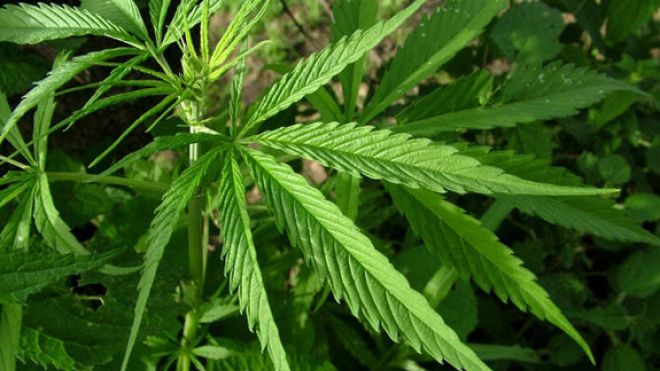
The pot doctor has a backache. As Mahmoud ElSohly, shakes my hand, he’s wincing. Two days ago, ElSohly—the director of the University of Mississippi’s Marijuana Project—bent down the wrong way and threw out his back. And unfortunately, this morning’s visit to his chiropractor didn’t help him much.
Ironically, just outside ElSohly’s office in the Waller Complex—behind bolted doors, coded chambers, and security cameras—lies a government-guarded farm where acres of a pain-relieving drug grow in his care. Only Elsohly isn’t thinking about lighting up: He knows too much.
Read a headline touting a pot study, and it’s likely referencing the University of Mississippi’s carefully cultivated Mexican marijuana. In fact, the National Institute on Drug Abuse has named this lab the country’s one legal source of marijuana for scientific studies. It’s been operating quietly since about 1968—growing, harvesting, processing, standardizing, and analyzing marijuana.
The farm grows strains for testing with varying amounts of pot’s potent ingredient, tetrahydrocannabinol or THC—also known as the chemical that makes you “high.� But it does more than that. “There are many indications for which THC would be a good medicine if you have the right formulations and dosing,� says ElSohly. Unfortunately, this is where the case for medical marijuana gets complicated.
“Does it lower intraocular pressure for glaucoma patients? Yes it does. Does it reduce anxiety? Yes it does. Does it stimulate appetite? Yes it does.�
– Mahmoud ElSohly, director of the University of Mississippi’s Marijuana Project
The marijuana plant is made up of more than 500 chemical compounds. Many of these compounds are cannabinoids, which bind to receptors in your body and then affect your immune system and brain. Researchers have pinpointed two main cannabinoids—THC and cannabidiol, or CBD—as beneficial, ElSohly tells me. (The biggest difference: CBD doesn’t make you high.)
Trouble is, when exposed to the high temperature of a burning joint, the 500 or so chemical compounds in marijuana can produce hundreds or thousands of byproducts—many of which are thought to be carcinogens. Research suggests that marijuana smoke can contain up to 70 percent more carcinogenic materials than tobacco smoke. And while many researchers think that—logically—marijuana smoke should cause lung cancer, studies remain inconclusive. (See Does Smoking Pot Cause Lung Cancer?)
But ElSohly contends that the smoke itself isn’t the biggest issue at this point. “There’s an inherent problem with the smoking of marijuana as a delivery system,� he says.
Forty-five years ago, Dr. Lester Grinspoon, now an associate professor emeritus of psychiatry at Harvard Medical School, would have never agreed with the idea of marijuana as a medicine. He thought his friends who lit up were ruining their health. Who would blame him? The U.S. government seemed to agree. In 1970, it classified marijuana as a Schedule I drug—alongside heroin and LSD—as a substance with high abuse potential and no accepted medical purpose.
But in 1967, Grinspoon’s teenage son was diagnosed with acute lymphocytic leukemia. Chemotherapy left him with no appetite, vomiting spells, and nausea—“the kind you feel right down to your toe nails,� the doctor remembers. The drugs that were supposed to ease the pain didn’t. So Grinspoon’s wife pulled up to Wellesley High School and asked her son’s friend for weed.
A few minutes before his treatments, Grinspoon’s son would take a few puffs. “We never—for as long as he lived—had to deal with that awful experience of seeing what he went through again,� he says.
But bring something you smoke to the medical world, and chances are they’ll balk at the idea. “Smoking is not an accepted route of administration for medication,� says Dr. Peter Friedmann, professor of Medicine & Community Health at Brown University. ;
“There are so many variables in the smoking process. It’s ludicrous to think you could come up with a dosage,� ElSohly adds.
This is, in part, why the FDA approved Marinol—a low-dosage formulation of synthetic THC that comes in capsule form. The drug is used to stimulate appetite in people with HIV and control the nausea and vomiting that’s associated with chemotherapy. It’s a good option for people with conditions like cancer who don’t respond to common drugs. It’s also incredibly versatile. ;
“Does it lower intraocular pressure for glaucoma patients? Yes it does. Does it reduce anxiety? Yes it does. Does it stimulate appetite? Yes it does,� ;ElSohly says. (Find out which health risk research suggests smoking marijuana could increase.) ;
The problem: Marinol is one of only two FDA-approved THC-based drugs and, unlike say, Advil, your body doesn’t absorb it well. Only about 10 to 20 percent of the dose becomes available for your body to use. That makes it unpredictable: For some people, the drug works great; others see no benefit whatsoever, says ElSohly. What’s more, it often makes those who it does work for higher than if they had smoked pot—another absorption issue.
Which leaves a clear challenge for researchers: Create a THC delivery method that leads to better absorption while reducing its psychoactive effect. ElSohly and his team are on track to do this at their Ole Miss research facility. They’ve developed a patch that would be applied above your gum line and deliver THC in a way that circumvents Marinol’s absorption problems. If approved, the product could be effective for relieving everything from nerve and cancer pain to glaucoma and anxiety.
Read about the dangers of marijuana and the issues raised by medical marijuana dispensaries.
source : http://www.foxnews.com/health/2013/05/10/truth-about-marijuana/